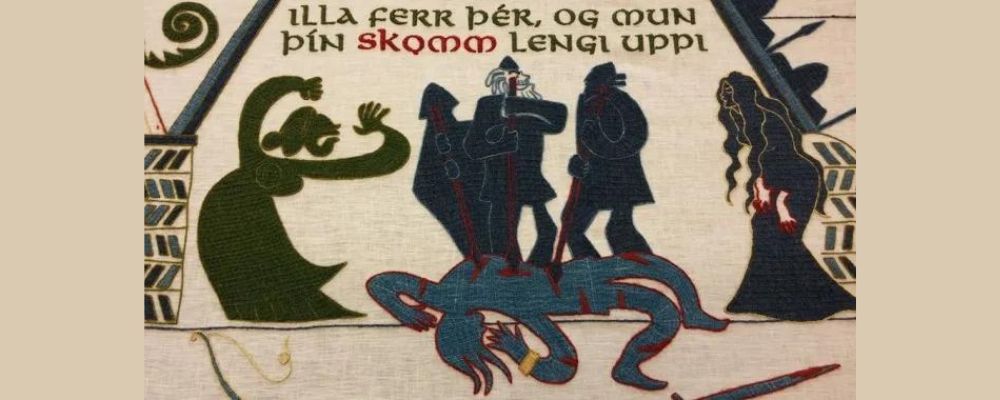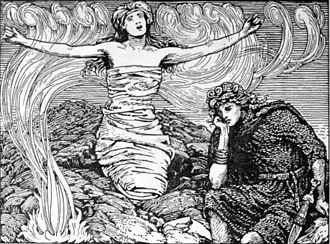The Mystery of Hamingja: Luck, Spirit, and Legacy in Norse and Germanic Belief
There’s a word in Old Norse that carries more weight than its simple translation lets on. That word is hamingja: often glossed as luck, but in truth, it’s something far deeper. It is a spirit, a force, a living current of fortune that flows through a person, their deeds, and even their bloodline.
To the ancient Norse and other Germanic peoples, hamingja wasn’t mere chance... it was an expression of one’s soul and the moral fabric of their life. It was the invisible measure of how well one lived in alignment with honor, kinship, and right relationship with the gods and the ancestors.
Let’s explore what this mysterious power was, how it worked, and what it still means for us today.
What Is Hamingja? More Than Just “Luck”.
In the sagas and early Norse sources, hamingja is described both as a person’s fortune and as a kind of guardian spirit that shapes the course of their life. Scholar Rudolf Simek defines it as “a kind of tutelary spirit determining the luck and happiness of a person” (Dictionary of Northern Mythology, 1993).
But it’s not a "coin toss" kind of luck... it’s earned luck. It’s the kind of fortune that grows through courage, generosity, integrity, and right action.
The Icelandic sagas speak of people who could lend their hamingja to another, sharing their spiritual strength so that others might succeed. In Óláfs saga helga, for example, the warrior Hjalti Skeggjason asks King Óláfr to “lay his hamingja” upon him before embarking on a dangerous expedition. This wasn’t symbolic encouragement... it was a real transfer of divine power, tied to the king’s own spirit and destiny.
So, when we talk about hamingja, we’re talking about more than personal luck. We’re talking about a living thread of power that runs through the family line, growing stronger or weaker depending on how we live.

The Hamingja as Spirit and Companion
Some sources suggest that the hamingja could even take form, appearing as a spirit-being or animal double (sometimes blending with the concepts of fylgja or hamr).
In Hrólfs saga kraka, the hero Böðvarr Bjarki’s spirit manifests as a great bear fighting beside his king... a powerful image of one’s inner might taking shape in the physical world.
Other tales describe a person’s hamingja appearing in dreams, warning of danger or signaling a turning of fate. Like a guardian spirit, it was thought to follow you through life, protecting you if you were in good standing , or leaving you if you strayed from the path of honor.
How Hamingja Can Be Damaged or Lost
The sagas make it clear that not all luck lasts forever. A person’s hamingja can be weakened, corrupted, or even lost. But not through superstition or random misfortune... rather, through choices that violate the moral and spiritual order of one’s world.
- Dishonor and Betrayal – Breaking oaths, committing cowardice, or acting without integrity could cause a person’s hamingja to turn away. A man who lost his honor in the eyes of his kin would soon find his fortune gone as well.
- Exile or Isolation – Because hamingja is bound to kinship and community, separation from one’s people could diminish its strength. A lone wanderer without bonds has no one to feed his spirit’s well of fortune.
- Curses and Hostile Magic – Norse sources are filled with accounts of seidhr and curses. A malicious practitioner might “bind” another’s luck, effectively harming their hamingja. In Egil’s Saga, the poet Egill carved a rune curse and erected a horse’s head on a pole to banish the guardian spirits of his enemies – essentially sending away their hamingja. As Neil Price discusses in The Viking Way (2002), the ancients took the manipulation of luck very seriously.

Healing and Restoring Hamingja
Though the sagas don’t contain a “manual” for repairing hamingja, they do show patterns: ways that one’s fortune and spirit could be restored. And for the modern Heathen, these methods still resonate deeply.
- Righting Wrongs - In Egil’s Saga, the hero repeatedly restores his standing through bold acts, generosity, and poetic expression. When we repair harm we’ve caused, we begin to reweave the torn fabric of our own luck.
- Honoring Ancestors and Gods - Since hamingja is often inherited, the living can strengthen it by building relationships with their forebears. Offerings, remembrance, and acts done in their name reinforce that living bond of fortune and spirit. Hilda Ellis Davidson noted that “luck and ancestral blessing were inseparable in early Northern belief” (The Road to Hel, 1943).
- Restoring Balance Through Deeds - The Norse idea of luck is reciprocal: what you give returns. Acts of courage, generosity, and creation strengthen your personal and family hamingja... while greed, cruelty, and apathy drain it away.
Think of it as a spiritual economy of honor. What you feed, grows.
The Growth and Transmission of Hamingja
One of the most fascinating aspects of hamingja is that it’s heritable. When someone dies, their hamingja doesn’t simply vanish: it continues on, often passing to a child or beloved kin. This is how families in the sagas explain the endurance of good fortune through generations.
A strong family line wasn’t just genetic, it was spiritual inheritance. The descendants of mighty, honorable people were said to carry a more powerful hamingja, a current of success flowing down through time.
In modern Heathen thought, we might say that our hamingja is strengthened when we live in ways that would make our ancestors proud... and that we, in turn, are building a stronger hamingja for those who come after us.

Where the Hamingja Goes After Death
So what happens when we die? According to several saga hints and later folklore, the hamingja doesn’t simply dissolve. It lingers, watching over kin, joining the host of the dísir... the ancestral female spirits who guide and protect their descendants.
In this way, a person’s luck - their hamingja - becomes part of their family’s living spirit. The deeds of the living feed the dead, and the strength of the dead empowers the living.
It’s a beautiful cycle: fortune, spirit, and kinship intertwined beyond death.
The Living Relationship: What Hamingja Does For Us Today
When we live in alignment with our virtues, honor our commitments, and maintain right relationships with both the living and the dead, we strengthen our hamingja. It manifests as intuition, confidence, synchronicity, and resilience... that subtle sense that the universe itself is working with you.
Conversely, when we lie, act selfishly, or neglect our oaths, our luck seems to sour - not because of cosmic punishment, but because we’ve cut ourselves off from the flow of our own spiritual vitality.
To live with a strong hamingja, then, is to live with courage, gratitude, and awareness that our spirit is not isolated ... it’s a part of something ancient and vast. The old Norse word hamingja might translate as “luck,” but it truly means relationship... to oneself, to the gods, to one’s kin, and to the deeds that define one’s name. When we honor our ancestors, live bravely, keep our word, and build good will, we are not only shaping our present. We’re weaving the fortune of those who will carry our name after us.
“Cattle die, and kinsmen die,
And so one dies oneself;
But the fair fame never dies
Of him who has earned it well.”
And that fame... that enduring luck, that living breath of legacy is nothing less than our hamingja.

Suggested Reading & Sources
- Óláfs saga helga (in Heimskringla) – the Hjalti Skeggjason episode.
- Hrólfs saga kraka – the bear-form spirit of Böðvarr Bjarki.
- Egils saga Skalla-Grímssonar – dreams, honour, and the ebb and flow of fortune.
- Rudolf Simek, Dictionary of Northern Mythology (1993).
- Neil Price, The Viking Way (2002).
- H.R. Ellis Davidson, The Road to Hel (1943)
- Andy Orchard, Dictionary of Norse Myth and Legend (1997).